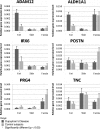Differential gene expression analysis of subcutaneous fat, fascia, and skin overlying a Dupuytren's disease nodule in comparison to control tissue
- PMID: 19184239
- PMCID: PMC2724615
- DOI: 10.1007/s11552-009-9164-0
Differential gene expression analysis of subcutaneous fat, fascia, and skin overlying a Dupuytren's disease nodule in comparison to control tissue
Abstract
Dupuytren's disease (DD) is a benign fibroproliferative tumor with an unknown etiology and high recurrence postsurgery. Several observations suggest the possible involvement of skin overlying nodule (SON) and the subcutaneous fat in the pathogenesis of DD. This study aims to (1) compare the gene expression levels of SON and subcutaneous fat in DD and normal subjects and (2) to compare transverse palmar fascia (Skoog's fibers) from DD patients as internal control tissue, with palmar fascia (transverse carpal ligament) from patients undergoing carpal tunnel release as external control. Skin, fat, and fascia were obtained from five DD patients of Caucasian origin (age = 66 +/- 14) and from five control subjects (age = 57 +/- 19) undergoing carpal tunnel release. Total ribonucleic acids was extracted from each sample and used for complementary deoxyribonucleic acid synthesis. Real-time quantitative polymerase chain reaction was used to assess the gene expression levels of six candidate genes: A disintegrin and metalloproteinase domain (ADAM12), aldehyde dehydrogenase 1 family member A1 (ALDH1A1), iroquois homeoboxprotein 6 (IRX6), periostin, osteoblast specific factor, proteoglycan 4, and tenascin C. Using independent t test, ADAM12, ALDH1A1, and IRX6 expression levels in DD fats were significantly (p < 0.05) higher than those in the controls. There is no significant difference in the gene expression levels of all six genes when comparing disease and control fascia and skin. Interestingly, ADAM12 up-regulation has also been observed in several other fibrotic and proliferative disorders. In conclusion, this study demonstrates potential roles for subcutaneous fat in DD pathogenesis as well as supports the use of transverse palmar fascia as appropriate control tissues in DD research.
Figures



Similar articles
-
Identification of mesenchymal stem cells in perinodular fat and skin in Dupuytren's disease: a potential source of myofibroblasts with implications for pathogenesis and therapy.Stem Cells Dev. 2012 Mar 1;21(4):609-22. doi: 10.1089/scd.2011.0140. Epub 2011 Jul 19. Stem Cells Dev. 2012. PMID: 21612554 Free PMC article. Clinical Trial.
-
Identification of biomarkers in Dupuytren's disease by comparative analysis of fibroblasts versus tissue biopsies in disease-specific phenotypes.J Hand Surg Am. 2009 Jan;34(1):124-36. doi: 10.1016/j.jhsa.2008.09.017. J Hand Surg Am. 2009. PMID: 19121738
-
Molecular phenotypic descriptors of Dupuytren's disease defined using informatics analysis of the transcriptome.J Hand Surg Am. 2008 Mar;33(3):359-72. doi: 10.1016/j.jhsa.2007.11.010. J Hand Surg Am. 2008. PMID: 18343292
-
Concurrent inhibition of TGF-β and mitogen driven signaling cascades in Dupuytren's disease - non-surgical treatment strategies from a signaling point of view.Med Hypotheses. 2012 Mar;78(3):385-8. doi: 10.1016/j.mehy.2011.11.023. Epub 2011 Dec 23. Med Hypotheses. 2012. PMID: 22196988 Review.
-
Genetics of Dupuytren's disease.Joint Bone Spine. 2012 Jan;79(1):7-12. doi: 10.1016/j.jbspin.2011.05.027. Epub 2011 Jul 30. Joint Bone Spine. 2012. PMID: 21803632 Review.
Cited by
-
Assessment of palmar subcutaneous tissue vascularization in patients with Dupuytren's contracture.World J Orthop. 2018 Sep 18;9(9):130-137. doi: 10.5312/wjo.v9.i9.130. eCollection 2018 Sep 18. World J Orthop. 2018. PMID: 30254969 Free PMC article.
-
Scientific understanding and clinical management of Dupuytren disease.Nat Rev Rheumatol. 2010 Dec;6(12):715-26. doi: 10.1038/nrrheum.2010.180. Epub 2010 Nov 9. Nat Rev Rheumatol. 2010. PMID: 21060335 Review.
-
Periostin as a multifunctional modulator of the wound healing response.Cell Tissue Res. 2016 Sep;365(3):453-65. doi: 10.1007/s00441-016-2426-6. Epub 2016 May 28. Cell Tissue Res. 2016. PMID: 27234502 Free PMC article. Review.
-
Identification of mesenchymal stem cells in perinodular fat and skin in Dupuytren's disease: a potential source of myofibroblasts with implications for pathogenesis and therapy.Stem Cells Dev. 2012 Mar 1;21(4):609-22. doi: 10.1089/scd.2011.0140. Epub 2011 Jul 19. Stem Cells Dev. 2012. PMID: 21612554 Free PMC article. Clinical Trial.
-
Identification of genetic variants associated with capecitabine-induced hand-foot syndrome through integration of patient and cell line genomic analyses.Pharmacogenet Genomics. 2014 May;24(5):231-7. doi: 10.1097/FPC.0000000000000037. Pharmacogenet Genomics. 2014. PMID: 24595012 Free PMC article.
References
-
- {'text': '', 'ref_index': 1, 'ids': [{'type': 'DOI', 'value': '10.1308/003588406X83104', 'is_inner': False, 'url': 'https://doi.org/10.1308/003588406x83104'}, {'type': 'PMC', 'value': 'PMC1963648', 'is_inner': False, 'url': 'https://pmc.ncbi.nlm.nih.gov/articles/PMC1963648/'}, {'type': 'PubMed', 'value': '16460628', 'is_inner': True, 'url': 'https://pubmed.ncbi.nlm.nih.gov/16460628/'}]}
- Bayat A, McGrouther DA. Management of Dupuytren’s disease—Clear advice for an elusive condition. Ann R Coll Surg Engl 2006;88:3–8. - PMC - PubMed
-
- {'text': '', 'ref_index': 1, 'ids': [{'type': 'PubMed', 'value': '8501389', 'is_inner': True, 'url': 'https://pubmed.ncbi.nlm.nih.gov/8501389/'}]}
- Bergenudd H, Lindgarde F, Nilsson BE. Prevalence of dupuytren’s contracture and its correlation with degenerative changes of the hands and feet and with criteria of general health. J Hand Surg 1993;18 B:254–7. - PubMed
-
- {'text': '', 'ref_index': 1, 'ids': [{'type': 'DOI', 'value': '10.1016/j.jhse.2005.02.002', 'is_inner': False, 'url': 'https://doi.org/10.1016/j.jhse.2005.02.002'}, {'type': 'PubMed', 'value': '17950195', 'is_inner': True, 'url': 'https://pubmed.ncbi.nlm.nih.gov/17950195/'}]}
- Burke FD, Proud G, Lawson IJ, et al. An assessment of the effects of exposure to vibration, smoking, alcohol and diabetes on the prevalence of dupuytren’s disease in 97,537 miners. J Hand Surg: European Volume 2007;32:400–6. - PubMed
-
- {'text': '', 'ref_index': 1, 'ids': [{'type': 'PubMed', 'value': '15586220', 'is_inner': True, 'url': 'https://pubmed.ncbi.nlm.nih.gov/15586220/'}]}
- Carl-McGrath S, Lendeckel U, Ebert M, et al. The disintegrin-metalloproteinases ADAM9, ADAM12, and ADAM15 are upregulated in gastric cancer. Int J Oncol 2005;26:17–24. - PubMed
-
- {'text': '', 'ref_index': 1, 'ids': [{'type': 'DOI', 'value': '10.1016/j.biochi.2006.11.005', 'is_inner': False, 'url': 'https://doi.org/10.1016/j.biochi.2006.11.005'}, {'type': 'PMC', 'value': 'PMC1885224', 'is_inner': False, 'url': 'https://pmc.ncbi.nlm.nih.gov/articles/PMC1885224/'}, {'type': 'PubMed', 'value': '17175089', 'is_inner': True, 'url': 'https://pubmed.ncbi.nlm.nih.gov/17175089/'}]}
- Collard F, Vertommen D, Fortpied J, et al. Identification of 3-deoxyglucosone dehydrogenase as aldehyde dehydrogenase 1A1 (retinaldehyde dehydrogenase 1). Biochimie 2007;89:369–73. - PMC - PubMed
LinkOut - more resources
Full Text Sources
Miscellaneous

